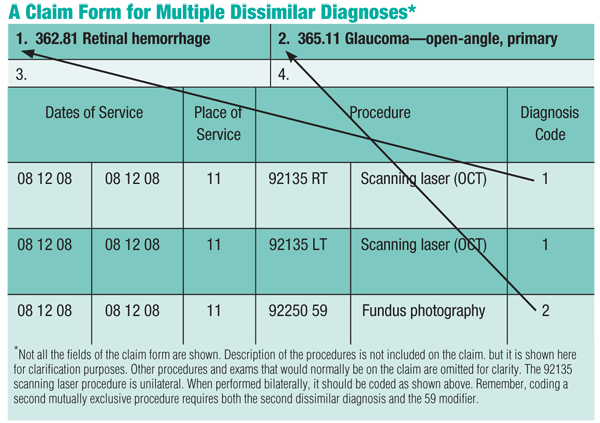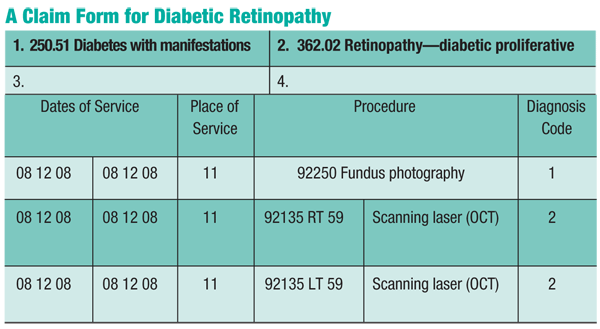| Typical Billing Codes for Supporting Diagnoses Made With SD-OCT*
• 361.xx: Retinal detachment. • 362.0x: Retinopathy––diabetic. • 362.1x: Retinopathy––hypertensive, exudative, etc. • 362.3x: Retinal––artery and vein occlusion. • 362.4x: Retinal––layer separation, hemorrhages, etc. • 362.5x: Macular degeneration. • 362.6x: Other retinal degenerations. • 362.7x: Retinal dystrophies. • 362.8x: Retinal––nerve fiber layer defects, edema, etc. • 365.xx: Glaucoma. *This list simply provides the common ranges of some diagnoses. Depending on your billing region, there may be additional supporting codes. |
Regional Coding Differences
A thorough understanding of the hierarchy and history of medical billing is critical to successful coding for SD-OCT. The Centers for Medicare and Medicaid Services (CMS) set a national policy for diagnoses that support various procedures. Known as the National Coverage Determinatioan (NCD), individual payers can modify these standards based on a Local Coverage Determination (LCD). Suffice it to say that there are many distinct differences between national and local standards, as well as differences within each of the LCDs for various regions. Remember: No region completely follows the national guidelines. One of the most common reasons for claim denial occurs when you assume that a diagnosis and procedural combination used in another part of the country will work in your region.
Keep Up to Date
Reimbursement guidelines change on a regular basis. What worked last year, or even last month, may not work now. Many regional payers change their LCDs throughout the year. In fact, with the CMS initiative to consolidate payers, frequent coding changes have become the norm. This is one of the main reasons why printing information out or using “cheat sheets” to determine what diagnoses support a procedure may not be beneficial. Equally important is the need to review the explanation of benefits (EOBs) provided by payers. Unfortunately, many practices do not review their EOBs carefully or at all, which results in recurrent improper claim reimbursement. So, remember to check your EOBs periodically. After all, it is your money. My office regularly receives calls from practice owners who were denied reimbursement for common procedures and were not even notified by their own billing staff.
Frequency Limitations
Each insurance provider has annual frequency limitations for SD-OCT examination billing. So, it is important to know what those individual guidelines are. Here are some typical frequency limitations:
• Mild-damage glaucoma: One test per year.
• Moderate-damage glaucoma: Up to two tests per year.
• Retinal disorders: Up to four tests per year.
• Macular degeneration: Up to one test per eye, per month.
• Advanced-damage glaucoma: Most insurers insist that scanning computerized ophthalmic diagnostic imaging is rarely necessary or beneficial. Pay particular attention when coding for advanced-damage glaucoma scans. Previously, when billing for advanced glaucoma, you could be reimbursed for as many as four SD-OCT scans per year. Now, however, most insurers consider any form of scanning laser unnecessary for advanced glaucoma. This procedural change in billing is being implemented nationwide.
| Examples of Mutually Exclusive Procedures*
• 92135: Scanning laser (OCT). • 92250: Fundus photography. • 92285: Photography––external ocular. • 92225: Ophthalmoscopy extended––initial. • 92226: Ophthalmoscopy extended––subsequent. • 92081-3: Visual fields (only in some regions). *There has been discussion as to whether these procedures are, in fact, mutually exclusive. But, regional LCDs do state that these are mutually exclusive procedures. |
In virtually every region, you must consider the logistical limitations associated with coding for mutually exclusive procedures (see “Examples of Mutually Exclusive Procedures,” left). If you perform two or more mutually exclusive procedures on the same day under a single diagnosis, you will be reimbursed for only one service. And generally, you will receive compensation for the procedure associated with the lowest level of reimbursement.
Here are three examples of how to ensure proper compensation when coding for mutually exclusive procedures:
• Single diagnosis. If a patient with a single diagnosis requires both an SD-OCT scan and fundus photography, perform the SD-OCT at the initial visit and schedule the fundus photo for another day.
• Multiple dissimilar diagnoses. You can perform more than one mutually exclusive procedure on the same day if the patient has multiple dissimilar diagnoses. In this instance, the second diagnosis must neither be related to nor caused by the primary diagnosis. And, you must clearly document that the second procedure is specifically for the second diagnosis and unrelated to the first diagnosis. For example, if the patient has a retinal issue and glaucoma, you are permitted to bill the SD-OCT for the retinal diagnosis and the fundus photo for the glaucoma diagnosis. However, you must ensure that the claim has the correct procedure/diagnosis links (see “A Claim Form for Multiple Dissimilar Diagnoses,” below).
 |
| You must have the pointer signifying the correct diagnoses. In this example, the diagnosis pointer for 92135 points to the first or primary diagnosis (362.81), and the diagnosis pointer for 92250 points to the second diagnosis (365.11). Some practices enter the actual diagnosis code in the pointer column, but this indication will be ignored. You must use the position number of the diagnoses (1, 2, 3, 4). |
• Diabetic retinopathy. Whenever you code for diabetic retinopathy (362.01/02), you are required to record diabetes as the primary diagnosis. Remember to code diabetes with ophthalmic manifestations (250.50-.53). This also allows you to perform both the SD-OCT scan and fundus photography when medically necessary. In this case, code the fundus photo to diabetes and the SD-OCT to diabetic retinopathy (see “A Claim Form for Diabetic Retinopathy,” below). Keep in mind that some SD-OCT devices combine the OCT measurement and fundus photograph in the same test.

In our experience, the majority of eye care providers either do not create an interpretation and report or do not submit one properly. For an SD-OCT scan, an interpretation and report is required. While not completing an interpretation and report should not affect your initial reimbursement, it could cost you later on if you are found to be non-compliant during an audit or review. The interpretation and report must contain the procedure and the associated diagnosis. Additionally, you must address three categories:
• Clinical findings: What did you find? • Comparative data/change in condition: Is the patient’s condition improving, stabilizing or worsening?
• Clinical management: What are you doing to manage the patient’s condition, medical regimen, referral or treatment? The interpretation and report is not filed with the claim. If the payer requests a report, however, you must provide it. If you have not completed or submitted these for previous procedures, you can be audited for each instance of non-compliance. Then, you could be fined for the full reimbursement as well as both interest and penalties. So, always complete an interpretation and report.
Ordering the Procedure
One final key to successful billing: Order the procedure in your exam notes. This is one of the most common reasons for reimbursement denial during an audit. You must also establish medical necessity when ordering the procedure. If you are audited and you have no order record in your examination notes, you will be denied complete reimbursement.
Though proper coding for SD-OCT can appear rather difficult, more than 130 different diagnoses support SD-OCT across all regions of the country. Just remember to thoroughly address five specific items:
• Order the procedure in your exam notes.
• Use a supporting diagnosis that is specific to your region.
• Do not bill other mutually exclusive procedures on the same day, unless you correctly code for multiple dissimilar diagnoses.
• Make sure you have not exceeded any frequency limitations for a given patient.
• Complete the interpretation and report. If you follow these five steps, you will ensure proper reimbursement for all procedures involving SD-OCT.
Mr. Rebello has been involved with medical coding and reimbursement for more than 25 years. He offers several CE-approved seminars on medical coding and delivers lectures across the country. He is president of Nteon Systems LLC, the creators of EyeCOR. Please direct all questions and comments to RRebello@nteon.com.

